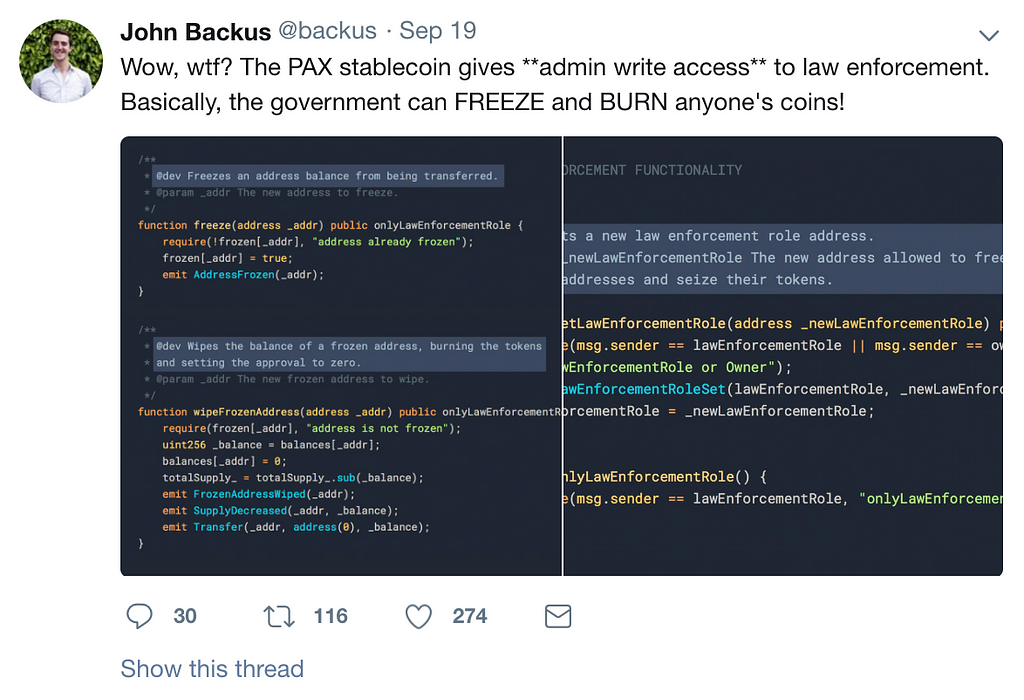Latest news about Bitcoin and all cryptocurrencies. Your daily crypto news habit.

And thus, a new coin was born! The latest coin to enter the eye of the public is called Paxos and is created by the company itBit. itBit made a name for itself trading Bitcoin/USD and EUR pairs. This company was part of the New York Attorney General’s report into virtual markets that was published last week, which analyzed some of the larger crypto exchanges and investor behavior on those platforms. itBit was one of the companies that volunteered to answer the Attorney General’s questions.
The idea behind Paxos is to issue a stablecoin that is backed by verifiable USD. This means that for every Paxos created, there is a dollar in a bank that is held as collateral.
How do you know the dollars are actually there in the bank? This question is the basis of the controversy surrounding Tether, another early stablecoin. The answer is where the Trust and the auditors come in. A Trust is a bank that takes custody of assets, in this case the US dollars acting as Paxos’ collateral. Using a Trust, which is a trusted source—hence the name, and an audit, you can assure investors that the money is really there in case you need to convert your Paxos into USD. Hypothetically, every Paxos user could convert into USD at once if they so choose.
There is probably some sort of insurance policy around Paxos as well. FDIC insurance (Federal Deposit Insurance Corporation insurance that provides protection to all depositors in US banks) only insures up to $250,000 per person, but private insurance policies can insure way more.
However, the real story about Paxos is this: a software developer found a strange line of code within Paxos’ open source library.
The Paxos Trust Company LLC released the source code for the stablecoin, so that anyone who can read code could take a look at what Paxos is built on. Why? Most blockchain projects are open source. Anyone can take the code, modify it and create their own version. This is part of the ethos of the community and the business. John Backus, who is a programmer in the Ethereum community, reviewed the code and found an interesting back door.
According to John, there is a way for Federal regulators to access Paxos stablecoins using the following functions: “setLawEnforcementRole”, “freeze” or “wipeFrozenAddress.” These functions allow regulators to freeze the stablecoins, meaning no owner could trade their coins, and more importantly, to wipe them, or burn the Paxos stablecoins into non-existence.
The company stands behind this and claims it is normal to allow regulators to control currencies, “Paxos has always been compliant as a core principle,” a Paxos spokesperson said. “Being able to freeze the systems is a desired capability to keep the token KYC friendly,” the spokesperson continued and iterated that they would only use the function setLawEnforcementRole if the law required it.
However, these functions are a real breakdown of the rules of decentralization. The ability for a third party to do whatever they want is not part of the idea of trustless. Imagine if Bitcoin had this function. How would this have changed the success Bitcoin has received?
In reality, regulation is the enemy of decentralization, I wrote about this in a previous post. It is clear to me that the future of finance and the future of blockchain lies in the convergence of regulation and decentralization, not in a network of pure decentralized systems. It is not possible in a society of laws to build a decentralized system that is outside the purview and control of our government. The system will fight it until it yields.
If you liked what you read, please clap 50x and give me a follow on Medium. We will be discussing topics like these at the StartEngine Summit on October 19th in Los Angeles. Click here to learn more and buy your ticket: www.startenginesummit.com
Stablecoin Wake Up Call was originally published in Hacker Noon on Medium, where people are continuing the conversation by highlighting and responding to this story.
Disclaimer
The views and opinions expressed in this article are solely those of the authors and do not reflect the views of Bitcoin Insider. Every investment and trading move involves risk - this is especially true for cryptocurrencies given their volatility. We strongly advise our readers to conduct their own research when making a decision.

